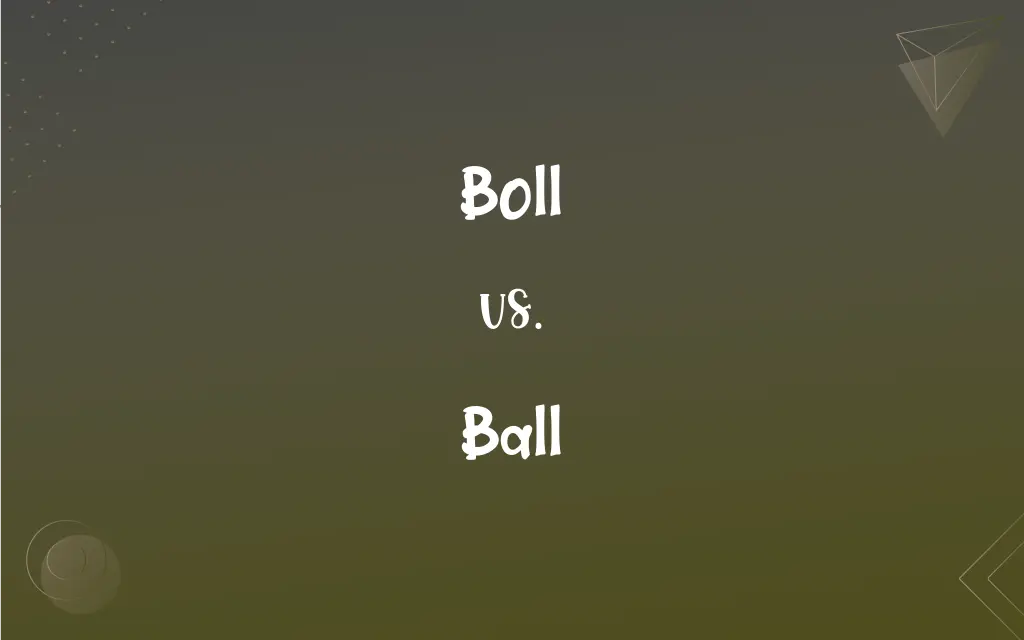Boll vs. Ball: What's the Difference?
Edited by Aimie Carlson || By Janet White || Updated on March 3, 2024
A boll is a plant seed pod, while a ball is a round object used in games and activities.

Key Differences
Bolls are protective cases around the seeds of certain plants, like cotton, designed to naturally open and release the seeds when mature. On the other hand, balls are spherical objects, often made of rubber, plastic, or leather, used for various games and sports, from basketball to soccer.
The nature of a boll is botanical, serving a specific role in plant reproduction by enclosing and protecting seeds until they are ready to disperse. Conversely, a ball's purpose is recreational, an essential component in numerous sports and games, designed to be durable, and its size, shape, and material are tailored to the specific requirements of each activity.
Bolls vary in size depending on the plant species but are generally small, with a structure that can split open to release seeds. Balls, however, come in a wide range of sizes, from small golf balls to large exercise balls, and are characterized by their uniform shape and the ability to roll or be thrown.
The term 'boll' is primarily used in agricultural and botanical contexts, highlighting its role in the lifecycle of certain plants. In contrast, 'ball' is a ubiquitous term in everyday language, synonymous with play, sports, and physical activities, reflecting its broad applicability and cultural significance.
Comparison Chart
Definition
A protective case around seeds of certain plants.
A spherical object used in games and activities.
ADVERTISEMENT
Purpose
To enclose and protect seeds for plant reproduction.
For recreational use in various sports and games.
Material
Organic, part of a plant.
Rubber, plastic, leather, etc.
Context
Agricultural, botanical.
Recreational, sports.
Size & Shape
Generally small, can split open.
Ranges from small to large, uniformly spherical.
Boll and Ball Definitions
Boll
Agricultural Significance.
The yield of cotton is often measured by the number of bolls per plant.
ADVERTISEMENT
Ball
Material Variety.
The tennis ball's rubber core makes it bounce high.
Boll
Seed Enclosure.
Each boll contained several seeds ready for dispersal.
Ball
Sports Essential.
Every game of basketball starts with a jump ball.
Boll
Protective Case.
The cotton boll split open, revealing the fluffy fibers inside.
Ball
Cultural Significance.
The ball dropped in Times Square, signaling the new year.
Boll
Plant Reproduction.
As the bolls mature, they open up to release the cotton seeds.
Ball
Recreational Object.
She kicked the soccer ball into the goal.
Boll
The seed-bearing capsule of certain plants, especially cotton and flax.
Ball
Spherical Shape.
The ball rolled down the hill effortlessly.
Boll
The rounded seed-bearing capsule of a cotton or flax plant.
Ball
A spherical or almost spherical body
A ball of flame.
Boll
A protuberance or excrescence growing on the trunks of some trees, a burl.
Ball
A spherical object or entity
A steel ball.
Boll
(Scotland) An old dry measure equal to six bushels.
Ball
Any of various movable and round or oblong objects used in various athletic activities and games.
Boll
To form a boll or seed vessel; to go to seed.
Ball
Such an object moving, thrown, hit, or kicked in a particular manner
A low ball.
A fair ball.
Boll
The pod or capsule of a plant, as of flax or cotton; a pericarp of a globular form.
Boll
A Scotch measure, formerly in use: for wheat and beans it contained four Winchester bushels; for oats, barley, and potatoes, six bushels. A boll of meal is 140 lbs. avoirdupois. Also, a measure for salt of two bushels.
Boll
To form a boll or seed vessel; to go to seed.
The barley was in the ear, and the flax was bolled.
Boll
The rounded seed-bearing capsule of a cotton or flax plant
Boll
German novelist and writer of short stories (1917-1985)
Boll
Botanical Term.
Boll rot is a significant concern for cotton farmers.
FAQs
How do bolls contribute to plant reproduction?
Bolls protect the seeds of a plant until they are ready to be dispersed, facilitating the plant's reproduction process.
What is a boll?
A boll is a protective case around the seeds of certain plants, such as cotton, designed to release the seeds when mature.
Can the term 'ball' refer to something other than a spherical object?
Yes, 'ball' can also refer to formal social gatherings for dancing, but in the context of this comparison, it pertains to the spherical object used in sports.
Is there any overlap between bolls and balls in usage?
No, bolls and balls serve distinctly different purposes, with bolls in botanical contexts and balls in recreational and sports settings.
Why are balls made in different sizes?
Balls are made in different sizes to suit the specific requirements of different sports and activities.
How does the structure of a boll benefit the plant?
The structure of a boll, which can split open when mature, efficiently releases seeds, aiding in the plant's propagation.
How is the size of a ball determined for each sport?
The size is determined by the sport's governing body, taking into account factors like playability, safety, and tradition.
What materials are commonly used to make balls?
Common materials include rubber, plastic, leather, and synthetic fabrics, depending on the ball's intended use.
What is a ball used for?
A ball is used in various games and activities, serving as a primary component in sports like soccer, basketball, and volleyball.
What sports do not use a spherical ball?
Sports like American football and rugby use an elongated ball, deviating from the spherical shape.
What factors influence the design of a ball for sports?
Factors include the sport's rules, the ball's desired bounce and aerodynamics, and the ease of handling by players.
Are balls used in any activities outside of sports?
Yes, balls are used in recreational activities, physical therapy, and educational games for children.
Are all bolls associated with cotton plants?
While cotton bolls are the most well-known, other plants also produce bolls as part of their seed development process.
Can bolls be affected by pests or diseases?
Yes, bolls can be susceptible to various pests and diseases, which can impact the quality and quantity of the seeds produced.
Do all bolls open naturally?
Most bolls are designed to open naturally when the seeds are mature, though environmental factors can affect this process.
What happens to the seeds once a boll opens?
Once a boll opens, the seeds are exposed and can be dispersed by natural forces like wind or water, or harvested for agricultural purposes.
How are new types of balls developed for sports?
New types are developed through research and innovation, often aiming to improve performance, safety, and durability.
Can bolls be found on all plant species?
No, bolls are specific to certain plant species, like cotton, and not all plants produce bolls as part of their reproductive process.
How are bolls harvested?
Bolls, especially in cotton farming, are harvested using mechanical pickers that remove the boll from the plant.
What role do balls play in cultural events?
Balls play significant roles in cultural events, such as the New Year's Eve ball drop in Times Square, symbolizing celebration and unity.
About Author
Written by
Janet WhiteJanet White has been an esteemed writer and blogger for Difference Wiki. Holding a Master's degree in Science and Medical Journalism from the prestigious Boston University, she has consistently demonstrated her expertise and passion for her field. When she's not immersed in her work, Janet relishes her time exercising, delving into a good book, and cherishing moments with friends and family.
Edited by
Aimie CarlsonAimie Carlson, holding a master's degree in English literature, is a fervent English language enthusiast. She lends her writing talents to Difference Wiki, a prominent website that specializes in comparisons, offering readers insightful analyses that both captivate and inform.































































